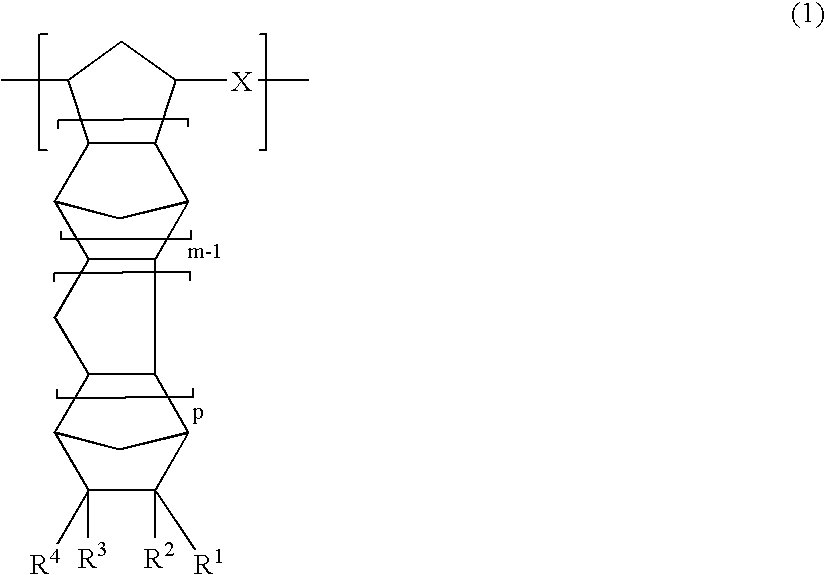Thermoplastic norbornene resin based optical film
a technology of optical film and thermoplastic norbornene, which is applied in the field of optical film, can solve the problems of film adhesion and variation, inferior bonding between film and polarizing plate, inferior adhesion of hard coat, etc., and achieves superior optical characteristics, good handling properties, and superior toughness.
- Summary
- Abstract
- Description
- Claims
- Application Information
AI Technical Summary
Benefits of technology
Problems solved by technology
Method used
Image
Examples
synthetic example 2
[0271] With the exception of using 200 parts of 8-methyl-8-methoxycarboxyt-etracyclo[4.4.0.1.sup.2,5.1.sup.7,10]-3-dodecene (the monomer A-1) and 50 parts of bicyclo[2.2.1]hept-2-ene (the monomer B-1), reaction was conducted in a similar manner to the synthetic example 1 to yield a hydrogenated polymer (hereafter referred to as resin (b-1)).
[0272] Measurement of the hydrogenation ratio and the proportion of the structural unit b derived from the monomer B-1 using 400 MHz .sup.1H-NMR produced results of 99.9% and 20.1% respectively. The proportion of the structural unit b was calculated in the same manner as for the synthetic example 1.270 MHz .sup.1H-NMR was also used to measure the proportion of the structural unit b for 3 separate samples obtained by GPC, with weight average molecular weights Mw of less than 10,000, between 10,000 and 30,000, and exceeding 30,000 respectively, and these results showed a variation from the aforementioned 20.1% of no more than 15%.
[0273] Measurement...
synthetic example 3
[0276] With the exception of using 210 parts of 8-methyl-8-methoxycarboxyt-etracyclo[4.4.0.1.sup.2,5.1.sup.7,10]-3-dodecene (the monomer A-1) and 40 parts of 5-phenylbicyclo[2.2.1]hept-2-ene (the monomer B-2), reaction was conducted in a similar manner to the synthetic example 1 to yield a hydrogenated polymer (hereafter referred to as resin (c-1)).
[0277] Measurement of the hydrogenation ratio and the proportion of the structural unit b derived from the monomer B-2 using 400 MHz .sup.1H-NMR produced results of 99.9% and 15.8% respectively. The proportion of the structural unit b was calculated from the absorption of the protons of the aromatic ring of the structural unit b which appears in a range between approximately 6 and 7 ppm, and the absorption of the protons of the alicyclic structures of the structural unit a and the structural unit b which appear in the range between 0.15 and 3 ppm.
[0278] 270 MHz .sup.1H-NMR was also used to measure the proportion of the b constituent for 3...
example 1
[0287] The aforementioned resin (a-1) was dissolved in toluene to produce a concentration of 30% (the viscosity of the solution at room temperature was 30,000 mPa.multidot.s), and an INVEX lab coater manufactured by Inoue Kinzoku Kogyo Co., Ltd. was then used to apply the solution to a PET film (Lumirror U94 manufactured by Toray Industries Co., Ltd.) of thickness 100 .mu.m which had been subjected to hydrophilic surface treatment with an acrylic acid based system (to improve the adhesion), in sufficient quantity to produce a film, on drying, with a thickness of 100 .mu.m. The film was then subjected to preliminary drying at 50.degree. C., and then secondary drying at 90.degree. C. The resin film was then peeled away from the PET film to yield a resin film (a-2). The residual solvent content of the thus obtained film was 0.5%. Using a similar method, a resin film (a-3) with a film thickness of 50 .mu.m and a residual solvent content of 0.4% was also produced. The total light transmi...
PUM
| Property | Measurement | Unit |
|---|---|---|
| Fraction | aaaaa | aaaaa |
| Percent by mass | aaaaa | aaaaa |
| Angle | aaaaa | aaaaa |
Abstract
Description
Claims
Application Information
 Login to View More
Login to View More - R&D
- Intellectual Property
- Life Sciences
- Materials
- Tech Scout
- Unparalleled Data Quality
- Higher Quality Content
- 60% Fewer Hallucinations
Browse by: Latest US Patents, China's latest patents, Technical Efficacy Thesaurus, Application Domain, Technology Topic, Popular Technical Reports.
© 2025 PatSnap. All rights reserved.Legal|Privacy policy|Modern Slavery Act Transparency Statement|Sitemap|About US| Contact US: help@patsnap.com



